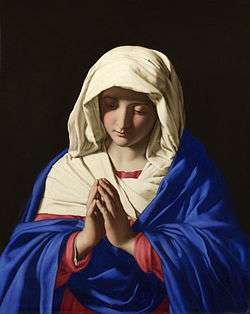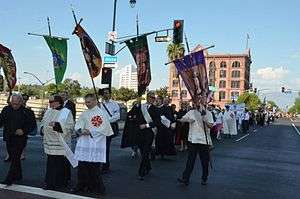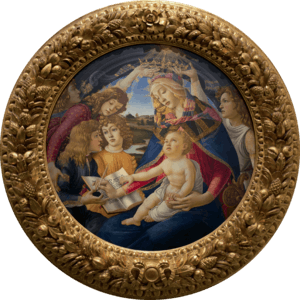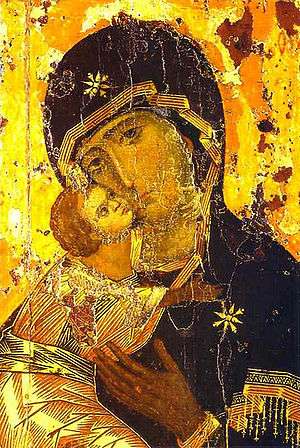Marian devotions

A Marian devotion in Christianity is directed to the person of Mary, mother of Jesus. The term "devotions" is commonly understood to refer to those external practices of piety by which the faith of an individual finds expression.[1]
Such prayers or acts may be accompanied by specific requests for Mary's intercession with God.[2][3] There are many Marian devotions, ranging from multi-day prayers such as novenas, the celebration of Canonical coronations granted by the Pope, the veneration of icons in Eastern Christianity, and pious acts which do not involve prayers, such as the wearing of scapulars or maintaining a Mary garden.[4]
Devotion to the Virgin Mary does not, however, amount to worship - which is reserved for God; e.g., both Catholics and the Eastern Orthodox view Mary as subordinate to Christ, but uniquely so, in that she is seen as above all other creatures. In 787 the Second Council of Nicaea affirmed a three-level hierarchy of latria, hyperdulia and dulia that applies to God, the Virgin Mary and then to the other saints.[5][6]
| A series of articles on |
| Mariology |
|---|
 |
| General perspective |
| Specific views |
|
|
| Prayers and devotions |
| Ecumenical |
|
|
Marian devotions are important to the Roman Catholic, Orthodox and Anglican traditions, but most Protestant views on Mary do not accept them, because such devotions are not recorded or promoted in the Bible. They believe this devotion may distract attention from Christ.[7] There is significant diversity of form and structure in Marian devotions practiced by different groups of Christians. Orthodox Marian devotions are well-defined and closely linked to liturgy, while Roman Catholic practices are wide-ranging.
Anglicanism
There is no single church with universal authority within the Anglican Communion; different types of Marian devotions are practiced by various groups of Anglicans with varying degrees of emphasis.[8] Within the Anglican Communion and the Continuing Anglican movement, devotions to the Virgin Mary have more emphasis within High Church and Broad Church parishes than others.

The emphasis placed on Mary and Marian devotions changed over the history of Anglicanism. In the 16th century, following the independence of the Church of England from Rome, a movement away from Marian themes took place; by 1552 mentions of Mary had been reduced to only two or three times a day in the Book of Common Prayer but the Marian feasts of the Annunciation and the Purification had been retained. However, in the 17th century, there was a gradual return to Marianism and by 1662 there were five Marian feasts.[9]
British devotion to the Virgin Mary has often been expressed in poetry, Marian hymns, and Carols, e.g., in the 17th-century poems of John Donne and George Herbert, or in the 18th-century works of Thomas Ken such as Saint Mary the Virgin.[10][11]
Anglican devotion for the Virgin Mary was revived during the 19th century Oxford Movement of Anglo-Catholicism and by the activities of prominent figures such as John Henry Newman.[12] British theologians such as Father Frederick Faber (who composed several hymns to Mary) took an enthusiastic approach to the promotion of Marian devotions towards the end of the 19th century.[13]
In the liturgical renewal of the 20th century, Mary gained new prominence, and in most Anglican prayer books she is mentioned by name in the Eucharistic prayers.[14] The gradual increase in Marian devotions among Anglicans has also been manifested within the higher levels of the clergy in the Anglican Communion. Archbishop of Canterbury Rowan Williams (who made a 2008 pilgrimage to Our Lady of Lourdes) wrote a book on how to pray with the icons of the Virgin Mary.[15][16]
Anglican devotions to Mary include the Anglican Rosary (similar to the Catholic rosary), votive candles, and pilgrimages to Walsingham and Lourdes. Some Anglicans and Anglo-Catholics also pray the rosary itself.[17][18][19] For centuries, Our Lady of Walsingham has been a centerpiece in Anglican devotions to the Virgin Mary and its feast is celebrated on October 15,[20] as well as a Catholic feast on September 24.[21][22] Also common in Anglican cathedrals, Anglo-Catholic parishes, and certain Anglican shrines are chapels or side altars dedicated to the Virgin Mary called Lady chapels.[23]
Discussions between Roman Catholics and Anglicans within frameworks such as the Anglican—Roman Catholic International Commission, and with the 2005 publication of the (non-binding) joint statement: Mary: grace and hope in Christ, have started a movement towards closer agreement of Mary and Marian devotions between Catholics and Anglicans.[24][25]
Lutheranism
Eastern Orthodoxy

A deep devotion to the "Aeipartenos" (i.e., Ever Virgin) Mary is one of the key themes of Orthodox liturgy and spirituality. Devotion to the Virgin Mary is "taken for granted" in Eastern Orthodoxy. It permeates the entire life of the Church and historically required no academic development as in the Western Church.[28]
In the Orthodox view, devotion to Mary is considered an important element of Christian spirituality, and indifference to her by other Christian denominations is troubling to the Orthodox.[29] Orthodox theologian Sergei Bulgakov called denominations that do not venerate the Virgin Mary "another type of Christianity".[30] [31]
The Theotokos (i.e., God-bearer, or Mother of God) title for Mary is very important in Eastern Orthodoxy and is seen as an affirmation of the fullness of God's incarnation.
The Orthodox approach to Marian devotions is characterized by three elements:
- Orthodox understandings of Mary have for centuries been mostly doxological and devotional rather than academic: they have been expressed in Marian hymns, liturgical poetry and the veneration of icons, rather than formal treatises. Marian devotions thus form the nucleolus of Orthodox Mariology.[32]
- Devotions to Mary are far more ingrained and integrated within Orthodox liturgy than any other Christian traditions, e.g., there are many more hymns to Mary within the Eastern Orthodox yearly cycle of liturgy than in Roman Catholic liturgy.[33] Feasts, icons and hymns are often combined, e.g., the Theotokos Iverskaya "wonder-working" icon is used on its own feast day, and the Akathistos is sung.[34]
- The Orthodox focus on Mary as the Theotokos gives more emphasis to devotions that praise Mary's role in the mystery of Incarnation, rather than other devotions, e.g., those that consider her sorrows at Calvary.[28] Devotions to the Theotokos are often combined with the veneration of icons depicting her with the Child Jesus. For instance, in the Sunday of Orthodoxy the singing of Marian hymns and the veneration of icons reaffirm the identity of Mary as the Theotokos.[35]
The Eastern Orthodox Church considers Mary to have been elevated by God to the highest status, above all other creatures, though still only a human being. The Orthodox hymn Axion Estin speaks of Mary as being "More honorable than the cherubim and more glorious beyond compare than the seraphim." Although most Orthodox consider Mary sinless, they do not accept the Roman Catholic definition of the Immaculate Conception of Mary.[31]
Mary is mentioned numerous times in all of the Divine Services and the Divine Liturgy. The final petition of each ektenia (litany) ends with an invocation of the Virgin Mary. When a series of troparia are chanted, the final one is often a Theotokion (hymn to the Virgin Mary). There are numerous Marian litanies in the Eastern church and may cover a multitude of themes, some dogmatic, others of moral and patriotic character.
Devotions to icons of the Theotokos (often considered miraculous) are common in Eastern Orthodoxy. Many such icons are considered the protector of a region, e.g., Our Lady of Kazan, the Theotokos Fyodorovskaya as the protector of the Upper Volga region and the Theotokos of Tolga as the patroness of Yaroslavl. A number of local (and often ancient) Orthodox Marian devotions also exist around the world, e.g., to the icon of the Theotokos of the Life-giving Spring in present-day Istanbul.
One of the most important Marian devotions is the Akathist to the Theotokos, which is chanted every year during Great Lent, and is frequently chanted throughout the year as a private devotion. Some people chant the Akathist as part of their preparation for Holy Communion. A metrical translation of an ancient Orthodox prayer is found in the second verse of the Anglican hymn, Ye Watchers and Ye Holy Ones.
Roman Catholicism

Marian devotions are prominent within the Roman Catholic tradition. Pope Paul VI began his Apostolic Exhortation Marialis Cultus saying, "From the moment when we were called to the See of Peter, we have constantly striven to enhance devotion to the Blessed Virgin Mary".[36]
In Rosarium Virginis Mariae, Pope John Paul II emphasized the importance of Marian devotions: "Since Mary is of all creatures the one most conformed to Jesus Christ, it follows that among all devotions that which most consecrates and conforms a soul to our Lord is devotion to Mary".[37]
At the popular level, for centuries books such as True Devotion to Mary have built a ground swell of Marian devotions among Catholics, to the point that tens of millions of pilgrims visit Marian shrines every year.[38] The statue of our Our Lady of Zapopan attracts over one million pilgrims on 12 October each year as the statue travels through the streets moving from one cathedral to another.[39][40]
Marian devotions can take a unifying national dimension, e.g., devotion to Our Lady of Guadalupe is a national symbol in Mexico, and in 1979 Pope John Paul II placed Mexico under her protection.[41] Similarly, national devotions to Our Lady of Šiluva resulted in Lithuania being formally consecrated to Mary by Cardinal Sladkevicius and the Chairman of the Lithuanian Parliament, in September 1991.[42]
Marian devotions are also associated with a number of beliefs among Catholics which have not been dogmatically approved by the Church, but have been asserted by saints and theologians. An example is the belief that devotion to Mary is a sign of predestination.[43] Saint Bernard of Clairvaux in the 12th century, Saint Bonaventure in the 13th century, and Saint Alphonsus Ligouri in the 18th century affirmed this belief, and 20th century theologian Reginald Garrigou-Lagrange, who taught Pope John Paul II, supported it with modern theological arguments regarding the "signs of predestination".[44][45][46]
Types of devotions
Marian devotions among Roman Catholics are numerous and have diverse cultural dimensions. While there are many well-known devotions, there are many small, local and regional devotions. At the top level Catholic Marian devotions may be categorized into the following non-exclusive groups, based on the characteristics of the devotion:
Liturgical calendar
Practically all Marian devotions and pious exercises are in some way related to the liturgical feasts of the General Calendar of the Roman Rite or of the particular calendars of dioceses and religious congregations. Saturdays are dedicated to the Virgin Mary, designated as memorials of the Blessed Virgin Mary. This practice derives from Carolingian times (ninth century).[47] The month of May has been traditionally dedicated to Mary.[48]
Prayers
The Angelus is a traditional prayer used to commemorate the Annunciation of the angel Gabriel to Mary. It is used three times daily: at dawn, mid-day and at dusk. During Eastertide, the Angelus is replaced with the Regina Coeli an antiphon, dating from the tenth or eleventh century. The Rosary, or Psalter of the Blessed Virgin Mary is essentially a contemplative prayer. The Litany of Loretto is the most well-known Marian litany.
Processions

Christians have often conducted processions honoring Mary. These processions have been largely restricted to Catholic and Orthodox cultures since the 16th century. In Los Angeles, California, a Marian procession took place annually for about the first 100 years following the founding of the city in 1781. The Queen of Angels Foundation, founded by Mark Anchor Albert, revived this annual procession in September 2011 in Downtown Los Angeles,[49] to coincide with the anniversary of the founding of the city.[50]
Other devotions
- Doctrine-based: These include the defined doctrines of Mary as Mother of God, Mary ever virgin, Mary conceived without sin, Mary assumed into heaven. The devotions may precede the dogmatic definition of the doctrine.[51][52][53] Such devotions can evolve over time, e.g., to the joint devotion to the Sacred and Immaculate Hearts of Jesus and Mary.[54][55] and may even receive official approval, while others may be deplored: in 1677, the Holy See condemned the belief that Mary herself was virginally conceived, which had been an idea surfacing occasionally since the 4th century.[56]
- Life of Mary: Specific episodes in the Life of the Virgin Mary have resulted in devotions that focus on a particular aspect of her life. Examples include the Seven Sorrows of Mary that recall her sufferings from the Prophecy of Simeon to the Crucifixion of Jesus. The Seven Joys of Mary on the other hand start with the Annunciation and end with her coronation in Heaven. Ongoing devotions such as Acts of Reparation to the Virgin Mary focus on her continued suffering at the present time as a result of insults and blasphemies.[57][58][59]
- Apparition-based: These include well-known and formally approved Marian apparitions such as Our Lady of Guadalupe, Our Lady of Lourdes, Our Lady of Fatima or Our Lady of Akita, and a multitude of regional devotions across the continents from Our Lady of Good Health in India to Our Lady of Licheń in Poland.[60][61] Such devotions have usually resulted in the construction of major Marian churches.[62]
- Miraculous images: Various icons, images and statues of the Virgin have been associated with reports of miraculous events such as healings and have resulted in local and national devotions, and the construction of Marian shrines. Examples include Our Lady of Aparecida in Brazil, the Black Madonna of Częstochowa in Poland, Our Lady of the Gate of Dawn in Lithuania, and Our Lady of San Juan de los Lagos in Mexico among many others.
- Devotional articles: Marian piety also includes various scapulars, the most common of which is the scapular of Our Lady of Mount Carmel.[63] Among the various medals of the Blessed Virgin Mary, the most diffuse is likely the "Miraculous Medal". Its origins go back to 1830.
There is also an interplay between these types of devotion, e.g., the apparitions of Lourdes emphasized the Rosary and those of Fatima reported the Virgin Mary with the Rosary and scapular. Regional devotions continue to generate local support such as festivals and celebrations. The festival of Our Lady of Solitude of Porta Vaga in the Philippines has been celebrated for centuries, and its icon continues to be venerated.[64] Each year around Pentecost, as part of a local Marian devotion, about a million people attend the Romería de El Rocío in Spain.[65]
Many other forms of devotional expression take place. For example, there has also been the long established practice of dedicating side altars in Catholic churches, often called Lady Chapels, to Mary.[66]
Major Roman Catholic devotions
See also
References
- ↑ "Directory on popular piety and the liturgy. Principles and guidelines". Congregation for Divine Worship. Retrieved 16 December 2014.
- ↑ Marmion, Columba. Christ, the Ideal of the Priest, 2006 ISBN 0-85244-657-8 p. 332
- ↑ Burke, Raymond L.; et al. (2008). Mariology: A Guide for Priests, Deacons, Seminarians, and Consecrated Persons ISBN 978-1-57918-355-4 pages 667-679
- ↑ "Catholic Encyclopedia: Popular Devotions". Retrieved 16 December 2014.
- ↑ Smith, Philip. The History of the Christian Church, 2009 ISBN 1-150-72245-2 p. 288
- ↑ Trigilio, John and Brighenti, Kenneth The Catholicism Answer Book 2007 ISBN 1-4022-0806-5 p. 58
- ↑ Hillerbrand, Hans Joachim, 2003. Encyclopedia of Protestantism, Volume 3 ISBN 0-415-92472-3 page 1174
- ↑ Milton, Anthony Catholic and Reformed 2002 ISBN 0-521-89329-1 page 5
- ↑ McLoughlin, William. Mary for Time and Eternity, Jill Pinnock 2007 ISBN 0-85244-651-9 pp. 4-7
- ↑ Tavard, George Henry. The thousand faces of the Virgin Mary, 1996 ISBN 0-8146-5914-4 pp. 153-161
- ↑ Ken, Thomas. Christian year: or, Hymns and poems for the holy days, 1868, Basil Montag Pickering Press, London, pp. 334-335
- ↑ Newman, John Henry. Mary: the Virgin Mary in the life and writings of John Henry Newman, 2001 ISBN 0-85244-529-6 pp. 15-18
- ↑ Brother Anthony Josemaria. The Blessed Virgin Mary in England, 2008 ISBN 0-595-50074-9 pp. 173-175
- ↑ Mary: grace and hope in Christ: the Seattle statement of the Anglican-Roman Catholics, Anglican/Roman Catholic International Group 2006 ISBN 0-8264-8155-8 p. 52
- ↑ McNally, Terrence, What Every Catholic Should Know about Mary ISBN 1-4415-1051-6 p. 169
- ↑ Williams, Rowan, 2002 Ponder these things: praying with icons of the Virgin ISBN 1-85311-362-X p. 7
- ↑ Schultz, Thomas.The Rosary for Episcopalians/Anglicans. 2003 ISBN 1-58790-055-6
- ↑ Duckworth, Penelope. Mary: The Imagination of Her Heart, 2004 ISBN 1-56101-260-2 p. 118
- ↑ Oggins, Robin S., Cathedrals, 2000 ISBN 0-281-05349-9 p. 43
- ↑ "Introduction". Shrine of Our Lady of Walsingham. Retrieved 16 December 2014.
- ↑ Obbard, Elizabeth. Every Pilgrim's Guide to Walsingham, 2007, ISBN 1-85311-808-7 pages 17 and 22
- ↑ The National Catholic Shrine of Our Lady of Walsingham
- ↑ Duckworth, pp. 125-126.
- ↑ Schroedel, Jenny The Everything Mary Book, 2006 ISBN 1-59337-713-4 pp. 81–85
- ↑ Mary: grace and hope in Christ, pp. 7–10.
- ↑ "Liturgy of the Word in honour of the Icon of the Mother of God of Kazan - August 25, 2004". Retrieved 16 December 2014.
- ↑ "Lauds in honour of the Blessed Virgin Mary, before the ancient icon of Our Lady, Mother of God of Kazan". Retrieved 16 December 2014.
- 1 2 Schmemann, Alexander. The Celebration of Faith: The Virgin Mary, 2001 ISBN 0-88141-141-8 pp. 59-62
- ↑ McGuckin, John Anthony. The Orthodox Church: An Introduction to its History, Doctrine, and Spiritual Culture, 2010 ISBN 1-4443-3731-9 pp. 210-215
- ↑ Bulgakov, Sergei, Nikolaevish. The Orthodox Church, 1997, ISBN 0-88141-051-9 p. 116
- 1 2 McNally, Terrence, What Every Catholic Should Know about Mary ISBN 1-4415-1051-6 pp. 168-169
- ↑ Schroedel, p. 90.
- ↑ McLoughlin, William, Mary Is for Everyone, Jill Pinnock 1998 ISBN 0-85244-429-X p. 183
- ↑ Tarasov, Oleg and Milner-Gulland, R. R., Icon and devotion, 2004 ISBN 1-86189-118-0 p. 86
- ↑ Vasilake, Maria. Images of the Mother of God: perceptions of the Theotokos in Byzantium, 2005 ISBN 0-7546-3603-8 pp, 95-98
- ↑ Pope Paul VI. "Apostolic Exhortation Marialis Cultus". Retrieved 16 December 2014.
- ↑ Pope John Paul II. "Apostolic Letter Rosarium Virginis Mariae". Retrieved 16 December 2014.
- ↑ "Shrine of Gualdalupe Most Popular in World". ZENIT International News Agency. Retrieved 1 Oct 2010.
- ↑ Rowe, William. Images of power: iconography, culture and state in Latin America, ISBN 1-57181-533-3 page 271
- ↑ Fodor's Mexico 1996 ISBN 0-679-03249-5 p. 242
- ↑ Norman, Edward R., The Roman Catholic Church: an illustrated history, p. 127
- ↑ "Our Lady of Siluva". Marian Library, University of Dayton. Retrieved 16 December 2014.
- ↑ McNally, pp. 144-147.
- ↑ Brother Anthony Josemaria, pp. 401-403.
- ↑ Fiat, M. Antoine. Life of Blessed John Gabriel Perboyre, Priest of the Congregation of the Mission, ISBN 1-115-29333-8, p. 56
- ↑ Liguori, Alphonsus. The Glories of Mary, 1868, ISBN 0-7648-0664-5 p. 139
- ↑ Directory on popular piety § 188.
- ↑ Socias, James. Handbook of Prayers, 2006 ISBN 0-87973-579-1 p. 483
- ↑ "Marian procession seeks prayer for Los Angeles on city's 'birthday'", EWTN News, August 17, 2011
- ↑ Rees, Brenda. "Sept. 3: A day for a spiritual procession and walking history" September 2, 2011
- ↑ Murphy, John F., Mary's Immaculate Heart, 2007 ISBN 1-4067-3409-8 pp. 59-60
- ↑ White, James F., Roman Catholic worship: Trent to today, 2003 ISBN 0-8146-6194-7 p. 34
- ↑ "Agenzia Fides - Congregazione per l'Evangelizzazione dei Popoli". Fides.org. Retrieved 2009-05-05.
- ↑ Calkins, Arthur. The Theology of the Alliance of the Two Hearts, Missio Immaculatae (English Edition) Year III, No 4 (May to December 2007)
- ↑ "Address to the participants of the International Symposium on the Alliance of the Hearts of Jesus and Mary". Retrieved 16 December 2014.
- ↑ "Catholic Encyclopedia: St. Anne". Retrieved 16 December 2014.
- ↑ Ball, Ann, 2003 Encyclopedia of Catholic Devotions and Practices ISBN 0-87973-910-X
- ↑ "Catholic Encyclopedia: Raccolta". Retrieved 16 December 2014.
- ↑ Christopher, Joseph P. et al., 2003 The Raccolta St Athanasius Press ISBN 978-0-9706526-6-9
- ↑ "Thousands of pilgrims throng Velankanni for Christmas". The Hindu. Retrieved 16 December 2014.
- ↑ "Address at Blessing of Marian Shrine (Lichen, 7 June 1999)". Retrieved 16 December 2014.
- ↑ Hermkens, Anna-Karina and Jansen, Willy. Moved by Mary: The Power of Pilgrimage in the Modern World, 2009 ISBN 0-7546-6789-8 p. 217
- ↑ "Catholic Encyclopedia: Scapular". Retrieved 16 December 2014.
- ↑ Aluit, Alphonso J., The Galleon guide to Philippine festivals, 1969 ASIN B004CWODBO p. 97
- ↑ El Rocío, Rough Guide to Spain. Retrieved 2010-04-14. Archived July 15, 2011, at the Wayback Machine.
- ↑
 Herbermann, Charles, ed. (1913). "Devotion to the Blessed Virgin Mary". Catholic Encyclopedia. New York: Robert Appleton Company.
Herbermann, Charles, ed. (1913). "Devotion to the Blessed Virgin Mary". Catholic Encyclopedia. New York: Robert Appleton Company.
Sources
- Brother Anthony Josemaria. The Blessed Virgin Mary in England, 2008 ISBN 0-595-50074-9
- Duckworth, Penelope. Mary: The Imagination of Her Heart, 2004 ISBN 1-56101-260-2
- Mary: grace and hope in Christ: the Seattle statement of the Anglican-Roman Catholics, Anglican/Roman Catholic International Group 2006 ISBN 0-8264-8155-8
- McNally, Terrence. What Every Catholic Should Know about Mary ISBN 1-4415-1051-6
- Schroedel, Jenny The Everything Mary Book, 2006 ISBN 1-59337-713-4

